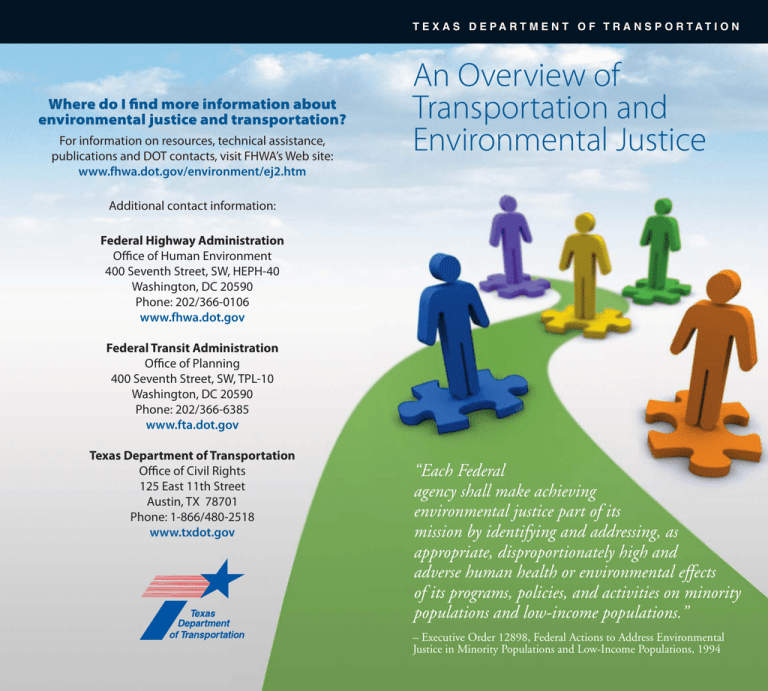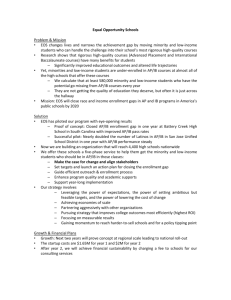An Overview of Transportation and Environmental Justice
advertisement

T E X A S D E PA R T M E N T O F T R A N S P O R TAT I O N Where do I find more information about environmental justice and transportation? For information on resources, technical assistance, publications and DOT contacts, visit FHWA’s Web site: www.fhwa.dot.gov/environment/ej2.htm An Overview of Transportation and Environmental Justice Additional contact information: Federal Highway Administration Office of Human Environment 400 Seventh Street, SW, HEPH-40 Washington, DC 20590 Phone: 202/366-0106 www.fhwa.dot.gov Federal Transit Administration Office of Planning 400 Seventh Street, SW, TPL-10 Washington, DC 20590 Phone: 202/366-6385 www.fta.dot.gov Texas Department of Transportation Office of Civil Rights 125 East 11th Street Austin, TX 78701 Phone: 1-866/480-2518 www.txdot.gov “Each Federal agency shall make achieving environmental justice part of its mission by identifying and addressing, as appropriate, disproportionately high and adverse human health or environmental effects of its programs, policies, and activities on minority populations and low-income populations.” – Executive Order 12898, Federal Actions to Address Environmental Justice in Minority Populations and Low-Income Populations, 1994 WHAT IS ENVIRONMENTAL JUSTICE? IS ENVIRONMENTAL JUSTICE A NEW REQUIREMENT? Presidential Executive Order 12898 directed every Federal agency to make environmental justice part of its mission by identifying and addressing the effects of all programs, policies and activities on “minority populations and low-income populations.” The requirements of this Executive Order extend to all recipients and subrecipients of Federal financial assistance. No. Federal-aid recipients have been required to ensure nondiscrimination in their programs and activities under Title VI of the Civil Rights Act of 1964 and many other laws, regulations and policies. In 1997, the U.S. Department of Transportation (U.S. DOT) issued its DOT Order to Address Environmental Justice in Minority Populations and Low-Income Populations to summarize and expand upon the requirements of Executive Order 12898 on environmental justice. There are three fundamental principles of environmental justice: 1. To avoid, minimize or mitigate disproportionately high and adverse human health and environmental effects, including social and economic effects, on minority populations and low-income populations. 2. To ensure the full and fair participation by all potentially affected communities in the transportation decisionmaking process. 3. To prevent the denial of, reduction in or significant delay in the receipt of benefits by minority and low-income populations. 2 Today, because of the evolution of the transportation planning process, Title VI and environmental justice are receiving greater emphasis. Effective transportation decision making depends upon understanding and properly addressing the unique needs of different socioeconomic groups. “No person in the United States shall, on the ground of race, color, or national origin be excluded from participation in, be denied the benefits of, or be subjected to discrimination under any program or activity receiving Federal financial assistance.” – Title VI of the Civil Rights Act of 1964 HOW DOES ENVIRONMENTAL JUSTICE IMPROVE TRANSPORTATION DECISION MAKING? Properly implemented, environmental justice principles and procedures improve all levels of transportation decision making. Implementing environmental justice principles allows TxDOT and its subrecipients to: • Make better transportation decisions that meet the needs of all people. • Design transportation facilities that fit more harmoniously into communities. • Enhance the public involvement process, strengthen communitybased partnerships and provide minority and low-income populations with opportunities to learn about and improve the quality and usefulness of transportation in their lives. • Improve data collection, monitoring and analysis tools that assess the needs of and analyze the potential impacts on minority and low-income populations. • Partner with other public and private programs to leverage transportation agency resources to achieve a common vision for communities. • Avoid disproportionately high and adverse impacts on minority and low-income populations. • Minimize and/or mitigate unavoidable impacts by identifying concerns early in the planning phase and providing offsetting initiatives and enhancement measures to benefit affected communities and neighborhoods. 3 The need to consider environmental justice is and policies such as: Title VI of the Civil Ri Policy Act of 1969 (NEPA) Section 109(h) of T Real Property Acquisition Policies Act of 1970 Act for the 21st Century (TEA-21) other U.S TITLE VI AND ENVIRONMENTAL JUSTICE ADDRESS WHICH GROUPS? Title VI of the Civil Rights Act prohibits discrimination on the basis of race, color and national origin. The DOT Order on Environmental Justice and Executive Order 12898 addresses persons belonging to any of the following groups: Black – a person having origins in any of the black racial groups of Africa. Hispanic – a person of Mexican, Puerto Rican, Cuban, Central or South American or other Spanish culture or origin, regardless of race. Asian American – a person from Asia, the Indian subcontinent or the Pacific Islands. American Indian and Alaskan Native – a person having origins in any of the original people of North America and who maintains cultural identification through tribal affiliation or community recognition. Low-Income – a person whose household income (or in the case of a community or group, whose median household income) is at or below the U.S. Department of Health and Human Services poverty guidelines. DO TITLE VI AND ENVIRONMENTAL JUSTICE APPLY TO ALL TRANSPORTATION DECISIONS? Yes. Concern for environmental justice should be integrated into every transportation decision – from the first thought about a transportation plan to postconstruction operations and maintenance. The U.S. DOT Order applies to all policies, programs and other activities that are undertaken, funded or approved by the Federal Highway Administration (FHWA), the Federal Transit Administration (FTA) or other U.S. DOT components to include: • Policy Decisions • Systems Planning • Metropolitan and Statewide Planning • Project Development and Environmental Review Under NEPA • Preliminary Design • Final Design Engineering • Right of Way • Construction • Operations and Maintenance 4 s already embodied in many laws, regulations ights Act of 1964 National Environmental Title 23 Uniform Relocation Assistance and 0 (URA), as amended Transportation Equity S. DOT statutes and regulations. HOW CAN TRANSPORTATION PARTNERS AND THE PUBLIC SUPPORT TITLE VI AND ENVIRONMENTAL JUSTICE? Environmental justice is more than a set of legal and regulatory obligations or a desktop exercise; it requires involving the public. TxDOT, transit providers and political subdivisions such as Regional Mobility Authorities (RMAs), toll authorities and Metropolitan Planning Organizations (MPOs) advance Title VI and environmental justice by involving the public in transportation decisions. Effective public involvement programs enable transportation professionals to develop systems, services and solutions that meet the needs of the public, including minority and low-income communities. Partners and stakeholders can use past successes to champion the opportunities and responsibilities that Title VI and environmental justice present. Texas Department of Transportation TxDOT is at the heart of planning, design, construction, operations and maintenance projects across the state. The department successfully integrates Title VI and environmental justice into its programs and activities by: • Developing and enhancing its technical capabilities to assess the benefits and adverse effects of transportation activities among different population groups and using those capabilities to develop appropriate procedures, goals and performance measures in all aspects of its mission. 5 • Ensuring that State Transportation Improvement Program (STIP) findings of statewide planning compliance and NEPA activities satisfy the letter and intent of Title VI requirements and environmental justice principles. • Enhancing its public involvement activities to ensure the meaningful participation of minority and low-income populations. • Working with Federal, state, local, and transit planning partners to create and enhance intermodal systems, and support projects that can improve the natural and human environments for low-income and minority communities. Regional Mobility Authorities and Metropolitan Planning Organizations Regional Mobility Authorities (RMAs) are political subdivisions that can accelerate needed transportation projects through the direction of a local board making local choices about local mobility needs to enhance the quality of life and economic growth of residents within a region. MPOs serve as the primary forum where TxDOT, transit providers, 6 local agencies and the public develop local transportation plans and programs that address a metropolitan area’s needs. MPOs can help local public officials understand how Title VI and environmental justice requirements improve planning and decision making. To certify compliance with Title VI and address environmental justice, RMAs and MPOs need to: • Enhance their analytical capabilities to ensure that the longrange transportation plans and the transportation improvement program (TIP) documents comply with Title VI. • Identify residential, employment and transportation patterns of low-income and minority populations so that their needs can be identified and addressed and the benefits and burdens of transportation investments can be fairly distributed. • Evaluate and, where necessary, improve their public involvement processes to eliminate participation barriers and engage minority and lowincome populations in transportation decision making. Transit Providers The Public Transit Providers offer mobility for all citizens whether they own a vehicle or not. They provide an essential service for many lowincome and minority populations who have no other way to get to work, shopping, child care, medical appointments, recreation or other destinations. Transit agencies support Title VI and environmental justice principles when they: Transportation agencies cannot fully meet community needs without the active participation of well-informed and empowered individuals, community groups and other nongovernmental organizations such as businesses and academic institutions. These individuals and groups advance the letter, spirit and intent of Title VI and environmental justice in transportation when they: • Ensure that new investments and changes in transit facilities, services, maintenance and vehicle replacement deliver equitable levels of service and benefits to minority and lowincome populations. • Participate in public involvement activities (meetings, hearings, advisory groups and task forces) to help responsible state and local agencies understand community needs, perceptions and goals. • Avoid, minimize or mitigate disproportionately high and adverse effects on minority and low-income populations. • Get involved with state and local agencies to link SAFETEA-LU programs with other federal, state and local resources to fund projects that support community goals. • Enhance public involvement activities to identify and address the needs of minority and lowincome populations in making transportation decisions. Safety and mobility are two of the U.S. Department of Transportation’s top priorities. Achieving environmental justice is another undeniable mission of the agency. 7 T E X A S D E PA R T M E N T O F T R A N S P O R TAT I O N Where do I find more information about environmental justice and transportation? For information on resources, technical assistance, publications and DOT contacts, visit FHWA’s Web site: www.fhwa.dot.gov/environment/ej2.htm An Overview of Transportation and Environmental Justice Additional contact information: Federal Highway Administration Office of Human Environment 400 Seventh Street, SW, HEPH-40 Washington, DC 20590 Phone: 202/366-0106 www.fhwa.dot.gov Federal Transit Administration Office of Planning 400 Seventh Street, SW, TPL-10 Washington, DC 20590 Phone: 202/366-6385 www.fta.dot.gov Texas Department of Transportation Office of Civil Rights 125 East 11th Street Austin, TX 78701 Phone: 1-866/480-2518 www.txdot.gov “Each Federal agency shall make achieving environmental justice part of its mission by identifying and addressing, as appropriate, disproportionately high and adverse human health or environmental effects of its programs, policies, and activities on minority populations and low-income populations.” – Executive Order 12898, Federal Actions to Address Environmental Justice in Minority Populations and Low-Income Populations, 1994



